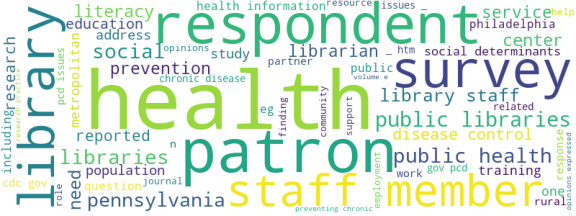| Id | 162 | |
| Author | Whiteman, E.D.; Dupuis, R.; Morgan, A.U.; D’Alonzo, B.; Epstein, C.; Klusaritz, H.; Cannuscio, C.C. | |
| Title | Public Libraries As Partners for Health | |
| Reference | Whiteman E.D., Dupuis R., Morgan A., D’Alonzo B., Epstein C., Klusaritz H. et al. Public libraries as partners for health. Health Prev Chronic Dis. 2018 15:E64. |
|
| Link to article | https://doi.org/10.5888/pcd15.170392 |
|
| Abstract | As centers for community engagement and education, public libraries provide ideal spaces for the transfer of health information, making them logical choices as partners for improving population health. More than 9,000 public library systems across the country host 1.5 billion in-person visits annually, exceeding the number of physician office visits by over 50% . During those visits, 42% of patrons report using libraries’ digital resources to search for health information. Literacy, a core mission of libraries, is a cornerstone of lifelong health. Higher literacy, including health literacy, is associated with increased levels of fulltime employment, on-time high school graduation rates, and a twofold reduced risk of uncontrolled diabetes. Recent research conducted in Philadelphia showed that public libraries often engage in health-related roles that extend beyond circulation of reading materials. More than a third of inquiries to public librarians include questions about health. Public libraries also serve as places of refuge for vulnerable populations, including people experiencing mental illness, homelessness, immigration challenges, and trauma. Library staff members regularly assist patrons who have unmet health and social needs, but feel ill-equipped to address these patron needs. Previous research has focused on librarians’ role in providing disease-specific consumer health information; however, little is known from surveys about the extent to which librarians are called on to assist patrons with social determinants of health, such as housing, employment, and education. The objective of our study was to investigate the frequency and methods library staff members use and are familiar with to address the social determinants of health. Our research — one of several steps taken by the Healthy Library Initiative to establish the feasibility of partnering with public libraries to improve population health — can be extended nationally to inform future partnerships between public libraries and the public health sector. |
|
| Keywords | public library; commuity engagement; staff; health |
Wordcloud:



